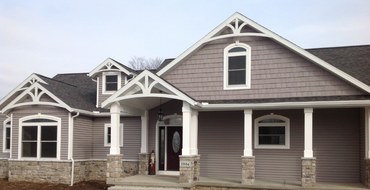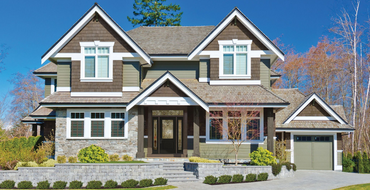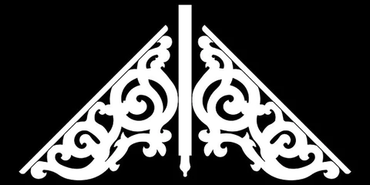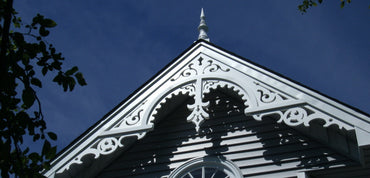
Exterior trim is an important finishing touch. It highlights the architectural style of a home, creates defining focal points, adds visual intrigue and boosts curb appeal. While decorative trim isn’t a structural component, it’s significant for adding character to your home and setting it apart from others.
There are many considerations when selecting decorative trim for your exterior facade. For example, there are different types and styles on the market that are designed to enhance a particular architectural style. Exploring the available options will provide inspiration and help you choose the style that works best for your home’s design.
More importantly, there are different material types to consider. Most builders and homeowners agree that PVC trim is an ideal choice for adding long-term beauty without the chore of ongoing maintenance — but it’s important to consider all your options.
This article will guide you through the different types, styles and materials for exterior trim. Plus, we’ll take a deeper look at the benefits of PVC trim to see why so many people prefer it to the other alternatives. After reading, you’ll know everything you need to know about PVC trim so you can accurately decide if it’s the right option to elevate your home.
The Different Types of House Trim
There are several types of house trim that can be used to accentuate the different areas of a home’s exterior. Here are some of the most prevalent exterior trim types:
- Door and Window Trim: Door and window trim is the most straightforward exterior trim type. It wraps around a home’s windows and doors to give it that polished finish. Without it, your home looks bland and boring.
- Porch Trim: Porch trim consists of several different components, but it refers to the molding that surrounds and accents a home’s porch or balcony. Porch trim consists of items such as column wraps, porch brackets, railing and spandrel molding.
- Column Wraps: Column wraps are a type of finishing touch that wraps around your existing porch supports (typically a 4x4 or 6x6 post they can wrap around any type of existing support). These are purely ornamental in nature and are meant to add an extra element of style to your home’s front elevation.
- Brackets, Corbels and Dentil Blocks: These items range from simple to ornate, and act as an accentuating element for creating focal points to specific areas of a facade.

- Gable Trim: Gable trim is a decorative element that’s added to the peaked areas of the roof. From small and intricate detailing to extravagant and large statements, gable decorations are an exterior trim option that really adds the “wow factor” to any architectural style.

- Shutters: Shutters, which can be made from various materials, help accentuate your windows to give your home a finished yet noteworthy look.

The Different Trim Materials
When it comes to choosing exterior trim for your home, being selective about the type of material it’s made from is crucial. It plays a major role in determining long-term factors beyond its aesthetic, like durability and ongoing maintenance. Following are the three most common material types to consider:
Wood
Wood is the most traditional material for exterior trim. It has an undeniable, natural beauty that’s difficult to replicate and is a favorite amongst homeowners and builders who appreciate authenticity. It’s also easy to paint and finish.
However, wood trim also comes with a number of downsides. For one, it can be pricey, depending on the wood species. Wood is also porous and susceptible to water damage, like cupping, warping and cracking. It’s also prone to insect damage, and it requires frequent maintenance to keep it looking its best.
Fiber Cement
Fiber cement is one of the more durable and longer-lasting options for exterior trim. It’s non-flammable and insect-resistant, making it a safe option for exterior trim. It can also be painted to fit your home’s design.
However, fiber cement is costly and challenging to install. Using it to make custom and unique designs is also more difficult. Instead, it’s best used for siding and simple trim.
PVC Trim
PVC (polyvinylchloride) is a synthetic plastic polymer that is impervious to moisture. For that reason, PVC is often used in pipes and plumbing fixtures. Thanks to its versatility, it is also a common material used in exterior home construction as it is manufactured in pressed board form which allows near limitless ability to create exterior accents from.
PVC trim can be cut, shaped, milled and routed just like wood trim, and doesn’t require any special tools for installation. Yet, unlike wood, moisture has no effect on it, it can withstand freeze and thaw cycles and it isn’t susceptible to insect damage.
In other words, you don’t have to worry about chipping, cracking, cupping, bowing, or rotting with PVC trim molding. It withstands the elements and is crafted to be durable and long-lasting. It’s also flame retardant, making it a much safer alternative to wood.
PVC can also be heat-formed, making it possible to create lavish and unique designs like what you see in Victorian gable trims, craftsman pediments, and gingerbread gable accents. It also makes custom exterior trim designs possible.
PVC is comparable in price to its wood alternatives but far less susceptible to sudden price fluctuations often seen in the wood/timber markets. As a result, PVC can be more reliable to budget into your project.
The Benefits of PVC Trim Molding
One appealing benefit of PVC is that it’s fully customizable. For homeowners looking to set their home apart, PVC can be crafted to intricate detail, molded to various shapes or even mimic the look of wood grain.
A second benefit of PVC trim is that it is naturally white and doesn’t require any painting or staining to exude beauty. Certain manufacturers — like PVC Millwork — use UV stabilizers to prevent yellowing from UV light. In addition, PVC trim can be painted for homes that need a pop of color.
Most of all, PVC trim will last a lifetime. PVC will never warp, crack, peel, rot or discolor — making it a top choice for homeowners who want to elevate curb appeal without the maintenance.
Getting Started with PVC Trim
There are a variety of types, styles and materials to consider for your exterior trim. However, there are many benefits that come with choosing PVC trim over the other material alternatives, including:
- Superior quality
- Increased durability
- UV- and moisture resistance
- Insect resistance
- Flame retardance
- No required painting or staining
- Low maintenance
- Affordable, visual impact
- Unlimited customization
If you’re ready to elevate your home with lifetime PVC gable trim or other accent trim decorations, an experienced fabricator can help you achieve the look you’ve always imagined. At PVC Millwork, we specialize in crafting quality exterior trim to ensure your home makes a lasting impact.
Check out our in-stock collections or contact us today for custom millwork fabrication.










